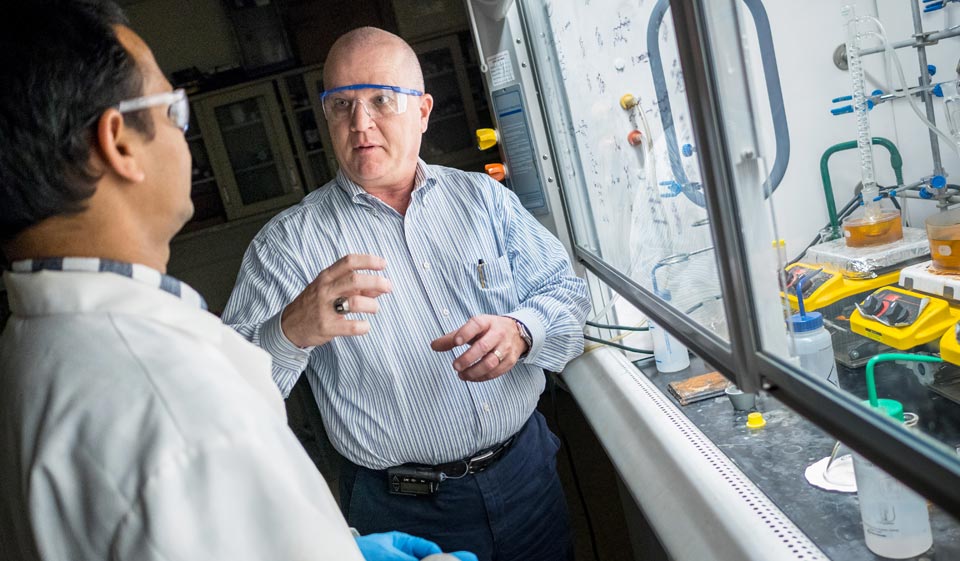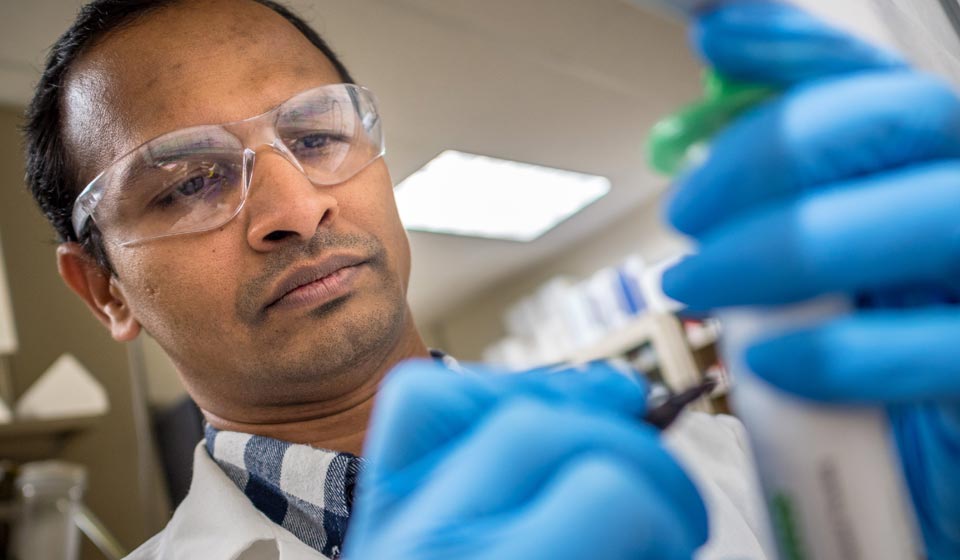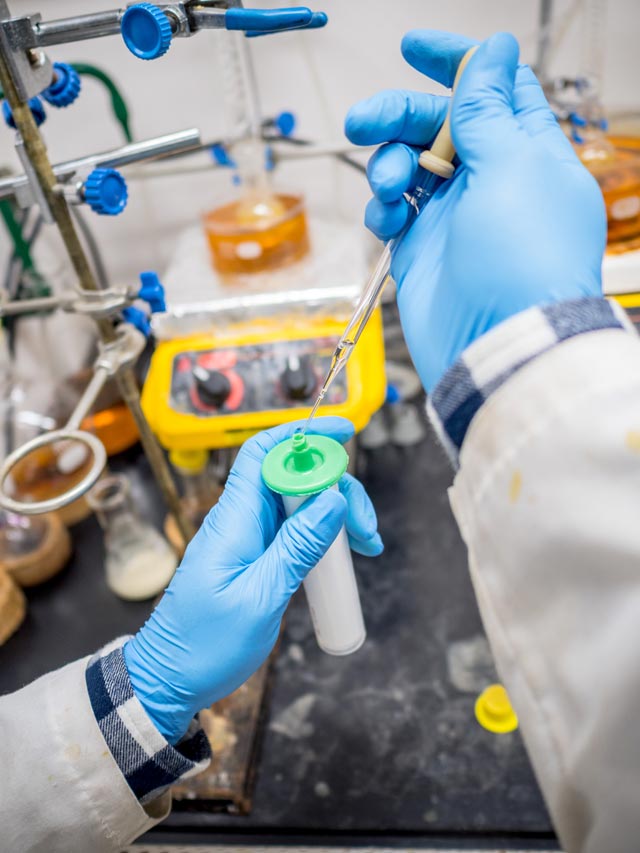Breaking Bad Bugs

Researchers fight bioterrorism with chemistry
Each year millions of people are injected with deadly botulinum toxin – or Botox – to combat everything from migraines and crossed eyes to wrinkles and excessive sweating. "When a minute amount is injected into a specific, localized area of the body by a highly trained plastic surgeon, it's generally safe," says David Rotella, the University's Sokol Professor of Chemistry.
In fact, Botox use has become so widespread it is easy to forget that it is the most lethal neurotoxin known to man. The same toxin that is such an effective weapon against the effects of aging causes botulism – a life-threatening disease characterized by paralysis and respiratory failure – and has the potential to be an even more powerful bioterror weapon.
Rotella has been awarded a $2.5 million, five-year contract from the Defense Threat Reduction Agency to help the United States combat bioterrorism by developing inhibitors of the lethal botulinum toxin.
"If you were exposed to it by food or water consumption or inhalation, the results could well be fatal," says Rotella.
Early symptoms include weakness, fatigue and difficulty speaking and seeing. Untreated, botulism can lead to paralysis, coma and death. While advances in palliative care have improved chances of survival in recent years, the mortality rate is still as high as 10 percent.
"The aim of this project is to identify a molecule or molecules that would provide either effective treatment for exposure to botulinum toxin, or provide prophylactic protection prior to exposure," Rotella explains. "I am just one part of the agency's comprehensive, long-term, multimillion-dollar commitment to finding an antidote to this serious bioterrorism weapon."
Third-year, post-doctoral scientist Sreedhar Tummalapalli works with Rotella in his lab. "It is very exciting to be able to contribute to finding an antidote for a deadly toxin that can protect our military and civilians in case of a bioterror attack," he says of working on the project.
According to College of Science and Mathematics Dean Robert Prezant, "This particular grant is one with international ramifications. The threat of bioterrorists finding mechanisms to exploit botulinum toxins means we need to be one step ahead to ensure we have corrective actions in place. This award brings the Sokol Institute, the College of Science and Mathematics and the University to a high level of recognition of what we are capable of on the global front."

David Rotella, right, talks with fellow researcher Sreedhar Tummalapalli about their work to find an antidote to the lethal botulinum toxin.
A powerful consortium
Rotella is a member of a consortium of scientists, pharmaceutical companies and government agencies receiving the defense agency funding to find an antidote to botulinum toxin.
His involvement with the consortium stems from a relationship he had with U.S. Army researchers, who were intrigued by findings they'd seen showing that small molecule enzyme inhibitors had successfully treated mice exposed to the toxin.
"They wanted to see if they could do this better. I told them I could think of ways to do that," recalls Rotella, who gained significant drug discovery experience as a former pharmaceutical industry research scientist. "For drug discovery to work, you need to identify an unmet medical need. Once you have done that, you need to determine how to approach and address this need. In this case, our consortium is working to disarm the botulinum toxin."
The project consortium includes the U.S. Army Medical Institute for Chemical Defense (USAMICD), the U.S. Department of Energy's Brookhaven National Laboratory, the University of Massachusetts at Dartmouth, the Naval Research Laboratory and pharmaceutical companies Ossianix and Hawaii Biotech.
"The consortium was designed to provide all the components – from synthesis to testing – needed to do successful drug discovery," Rotella recalls. "Each member of the group brings a specific and essential area of expertise to the project."
In the world of drug discovery, according to Rotella, there are two kinds of molecules – small and large. Once approved by the FDA, the molecules are referred to as drugs, like Crestor, a small molecule statin that slows the production of cholesterol, or Humira, a popularly prescribed large molecule antiinflammatory drug.
While researchers have been looking for ways to both protect and treat people exposed to botulinum toxin for a number of years, this consortium is unique in considering both small molecules and large molecules as potential drug candidates.

Sreedhar Tummalapalli works in the lab.
Disarming a deadly bacterium
"I'm a small molecule guy," Rotella says. "My job here is to investigate small molecules that might inhibit the enzyme botulinum A protease and that could eventually be tested in clinical trials." He has already established comparative standards for the labs to use to calibrate results and has begun to synthesize new molecules, or drug candidates.
These small molecule inhibitors will be sent to other labs for testing. "Once we identify molecules that are effective against the botulinum toxin protease, they would be tested on cells, tissues, animals and ultimately humans," Rotella explains. The FDA requires extensive clinical trials before approving any new treatment for use in humans.
John Siekierka, Montclair State chemistry and biochemistry professor and director of the University's Margaret and Herman Sokol Institute for Pharmaceutical Life Sciences, is also involved in preliminary testing.
"In case botulinum toxin is used as a bioweapon, it is important to have a safe treatment for exposure," he says. "My lab is testing potential drug candidates on normal human liver cells to determine if they are safe."
If a molecule kills human cells, it would be immediately ruled out as a potential drug candidate.
The work on Rotella's drug candidates is compatible with work underway in Siekierka's lab. "In the Sokol Institute, we are developing antiparasitic compounds that inhibit kinase pathways. These compounds may be tested in the same hepatocytotoxicity assay we're using for the botulinum toxin inhibitors to determine their safety profile," Siekierka notes. "Some of the students working in the Sokol lab will be helping in growing the cells for the botulinum toxin tests."

The roles of Rotella's fellow consortium members are clearly defined as the following:
Researchers at the U.S. Army Medical Institute for Chemical Defense, which has been working with the toxin for at least 15 years, have the ability to test the molecules that might be provided in test tubes or on mice.
- Scientists at the University of Massachusetts at Dartmouth will screen small molecules to offer access to other small molecule starting points, increasing the likelihood of finding a molecule that works.
- Researchers at Brookhaven National Laboratory are using X-ray crystallography to provide helpful pictures showing just how and where the molecules interact on larger proteins.
- Irish pharmaceutical company Ossianix has the unique ability to show how antibodies interact with foreign proteins, while pharmaceutical company Hawaii Biotech has identified another class of small molecules that could also prove promising.
- In its work with antibodies, the Naval Research Laboratory is exploring ways to deliver large molecules to patients effectively. "The large molecule approach is separate, but entirely complementary," says Rotella. "We won't know which approach will be successful until we identify both large and small molecule drug candidates."
"Bacteria and viruses are powerful organisms and the botulinum toxin produced by the bacterium Clostridium botulinum has the advantage of being readily available and the potential to be easily distributed," says Rotella.
"Not to scare people, but the very real threat posed by botulinum toxin has been recognized for years," he says. "Our hope is to discover a simple and effective antidote that could be made available to both military personnel and civilians and help us combat this very real bioterrorism threat."
